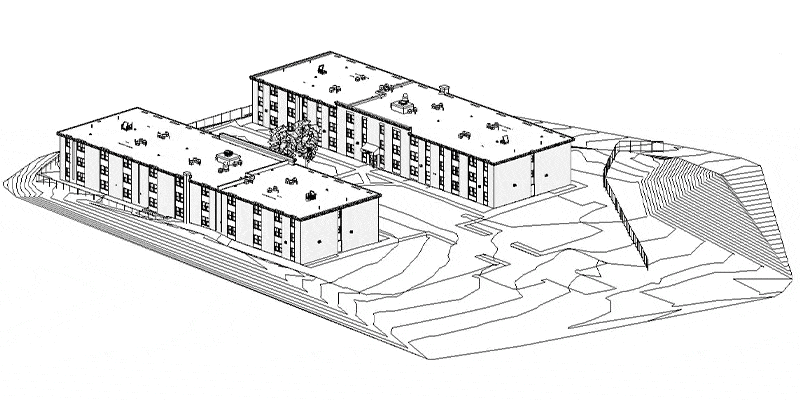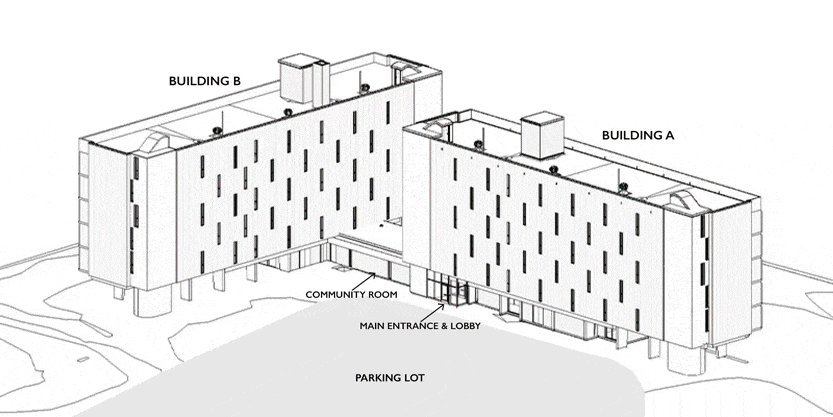Not surprisingly, construction and renovation projects are easiest to complete when a structure is unoccupied. However, in some cases, it is desirable or even necessary to maintain partial occupancy throughout a project. In those instances, careful sequencing of construction activities, open lines of communication, and effective collaboration are essential.
Construction Sequencing and Multifamily Properties
Sequencing construction activities so as to enable ongoing occupancy is particularly challenging in multifamily housing renovation projects. Recently, Patriquin Architects addressed that challenge at two different multifamily housing properties in New Haven, CT. Renovation projects at the Winslow Celentano and Fairmont Heights communities demonstrated two different, but successful, approaches to construction sequencing.
- Winslow Celentano consists of two towers of units, with work taking place in two distinct construction phases—one for each tower. This means occupants are moved out in two distinct phases.
- Fairmont Heights consists of two towers of units, with six distinct construction phases—one for each floor, with each building having three floors. This means occupants are moved out in six distinct phases.

While different methodologies were called for, the goals in every project of this type are the same: to minimize disruption for residents while maximizing construction efficiency.
5 Key Considerations for Construction Sequencing
We have found that regardless of how a construction project is sequenced, to ensure that some or all occupants or residents have uninterrupted access to a space, there are five important considerations to keep in mind.
- The construction phase for each floor or building is more compressed than a typical single construction period. This means that many of the typical administrative processes of construction need to be expedited—in particular, review and approval of products through “submittals.” In phased construction, there is often a much shorter time frame in which to review submitted products and materials before they are required on site for installation in the first phase.
- The overall construction period tends to be slightly longer, and requires that trades—electricians, cabinetry installers, sheetrock installers, etc.—be on site multiple times during a project. In typical, non-phased construction, the contractor tries to limit the number of times a particular trade must be on site. In phased construction, trade workers need to return to the site and remobilize multiple times.
- Care for the remaining occupants is of the utmost importance during construction projects where partial occupancy is maintained. For example, if hazardous materials are being abated and removed in each phase of construction, extreme care must be taken to protect occupants from this activity. Similarly, construction logistics must be coordinated so as to minimally disrupt the daily movements of remaining tenants. This may include coordinating elevator use, parking, or the loading and unloading of materials.
- Particularly in housing, where units renovated in different phases might receive the same general design updates, early construction phases often inform subsequent ones. This may be particularly true as the project team works together to develop solutions to unexpected field conditions that come to light early on.
- “Punch listing”—one of the major milestones and responsibilities of the architect during construction—must be completed multiple times. This is the process near the end of construction by which the architect reviews the contractor’s work for conformance to the construction documents. It typically involves a methodical survey of all rooms or units completed. Once the architect determines that all the items marked on the punch list as needing attention have been completed or corrected, they can determine that the work is “substantially complete.” In phased construction, this process is completed at the end of each phase.
Our Unique Approach to Construction Sequencing
Given the complexity of construction in a phased project, and the implications for everyone affected, it is crucial that the decision to sequence construction and maintain partial occupancy is one that is agreed to by all parties. This includes the owner, but also the contractor, architect, and any property management company responsible for occupants.
However, if it is possible to safely and efficiently achieve partial occupancy through a phased-construction approach, there are major benefits to displacing occupants (or tenants, in the case of multifamily housing) for shorter periods of time.
You can learn more about our full range of services and our firm in general on our website. You can also view showcase projects in our portfolio. And, if you have questions, please contact us at your convenience.

